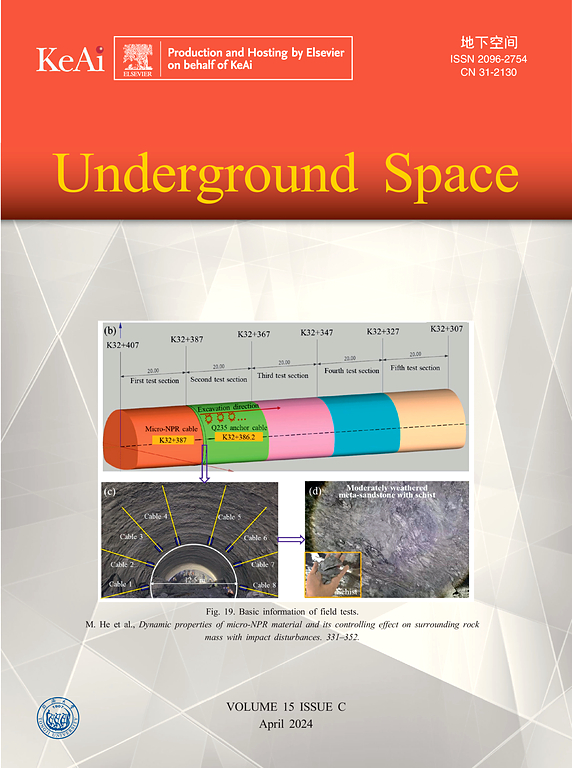一种等效爆破动静作用的岩石爆破模拟方法
IF 8.3
1区 工程技术
Q1 ENGINEERING, CIVIL
引用次数: 0
摘要
地下工程中各种爆破方法都涉及封闭空间的破岩过程。岩石爆破的整个过程是由爆破波和爆炸气体共同作用完成的。这两种作用在不同的时间和空间阶段表现出不同的爆破破裂特征。本文提出了一种等效爆破动-静作用的岩石爆破模拟方法。进行了一组平面应变条件下的模型爆破试验,从可行性和可靠性两个方面进行了验证。结果表明,新方法在破岩特性和压力波特性方面实现了冲击波与爆炸气体的有效耦合。模拟结果与实验结果具有较高的相似性,爆破损伤范围和峰值应力的最大误差分别为4.02%和8.90%。讨论了地下工程中三种爆破方式对爆破波和爆炸气体的破岩机理。对新方法的优越性进行了评价。当解耦系数增大时,发现一个最优解耦系数,反映了爆破结果与实际情况的一致性。当围压增大时,对准静态作用的抑制能力明显强于爆破动态作用。在开槽爆破中,准静力作用是孔侵彻形成的主要因素。模拟结果确定了爆破波与爆炸气井之间的破岩贡献。这种新的模拟方法可以为认识岩石爆破机理和还原整个爆破过程提供可靠的工具。本文章由计算机程序翻译,如有差异,请以英文原文为准。
An approach of rock blasting simulation of equivalent blasting dynamic-static action
Various blasting methods in underground engineering involve rock-breaking processes in enclosed spaces. A whole process of rock blasting is completed by the combination of blasting waves and explosion gas. The two actions exhibit different blasting fracturing characteristics in different time and spatial stages. In this study, an approach of rock blasting simulation of equivalent blasting dynamic-static action is proposed. A set of model blasting experiments under plane strain conditions are carried out to verify from the aspects of feasibility and reliability. The results show that the new method realizes the effective coupling of blast waves and explosion gas in terms of rock-breaking characteristics and pressure wave characteristics. The blasting effects have a high similarity between the simulation result and experimental result, and the maximum error on the damage range and the peak stress is 4.02% and 8.90%. The rock breaking mechanisms of three blasting methods in underground engineering that affect the blasting waves and explosion gas are discussed. The superiority of the new method is evaluated. When the decoupling coefficient is increased, an optimal decoupling coefficient is discovered, which reflects the consistency between the blasting results and the actual situation. When the confining pressure is increased, the inhibition ability on quasi-static action is obviously stronger than that of blasting dynamic action. In slotting blasting, the quasi-static action is the main contributor in the formation of holes penetration. The simulation results identify the rock breaking contributions between blasting waves and explosion gas well. The new simulation method can provide a reliable tool for understanding of the rock-blasting mechanism and restoring the whole blasting process.
求助全文
通过发布文献求助,成功后即可免费获取论文全文。
去求助
来源期刊

Underground Space
ENGINEERING, CIVIL-
CiteScore
10.20
自引率
14.10%
发文量
71
审稿时长
63 days
期刊介绍:
Underground Space is an open access international journal without article processing charges (APC) committed to serving as a scientific forum for researchers and practitioners in the field of underground engineering. The journal welcomes manuscripts that deal with original theories, methods, technologies, and important applications throughout the life-cycle of underground projects, including planning, design, operation and maintenance, disaster prevention, and demolition. The journal is particularly interested in manuscripts related to the latest development of smart underground engineering from the perspectives of resilience, resources saving, environmental friendliness, humanity, and artificial intelligence. The manuscripts are expected to have significant innovation and potential impact in the field of underground engineering, and should have clear association with or application in underground projects.
 求助内容:
求助内容: 应助结果提醒方式:
应助结果提醒方式:


